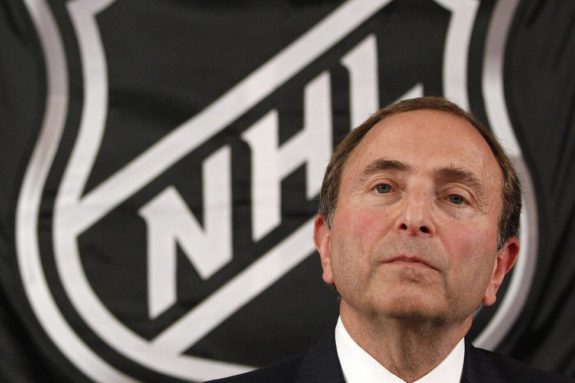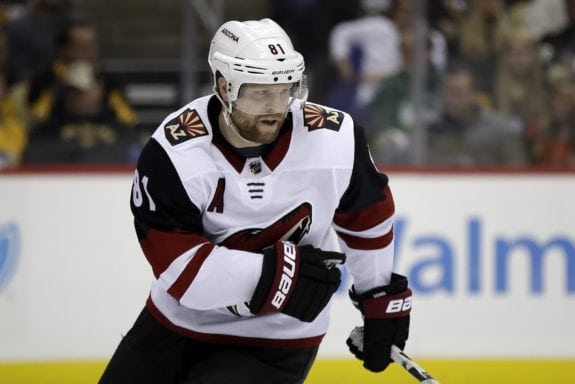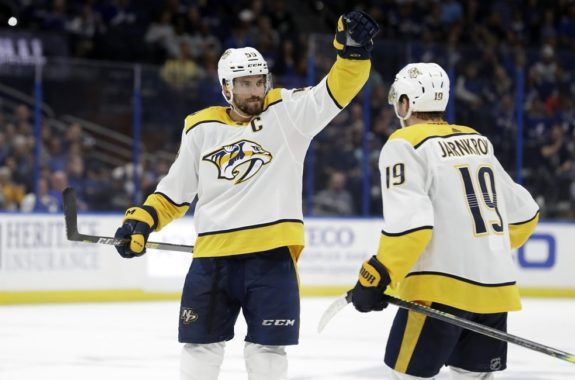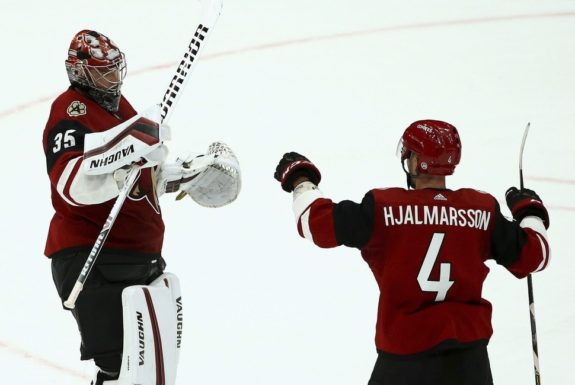Barring any major COVID-19-related setbacks, the National Hockey League is set to resume play after a 141-day layoff on August 1, with exhibition games starting on July 28.
In case you need a refresher, and, with everything going on in the world lately, we can’t blame you if you do, there will be 24 teams fighting for the Stanley Cup this year, instead of the usual 16. The No. 5 through No. 12 teams in both the East and West will play in a “qualifying round” to decide who will reach the final 16-team playoff field, while the top four clubs in each conference will play a round-robin tournament to determine their seeding for the first round, which will take place following the qualifying round.
Now, here’s the exciting part – for the first time since 2012, the Arizona Coyotes will be involved. A seven-year playoff drought is effectively over, and the team will resume play as the West’s No. 11 seed with a 33-29-8 record and 74 points.

Although many have lamented the fact that several “average” teams will be involved in the playoffs this year, the Coyotes are most decidedly not one of these teams. Prior to losing Vezina Trophy contender Darcy Kuemper to a lower-body injury on Dec. 19, the ‘Yotes were riding high with a 20-12-4 record. That’s a 100-point pace over a full season, so now, with a healthy roster, this is a team that belongs in the playoff field.
Once the playoffs begin, Arizona will find itself matched up with the No. 6-seeded Nashville Predators. The teams split the season series in 2019-20 – Rick Tocchet’s group took a 5-2 decision in Glendale on Oct. 17, while the Preds earned a 3-2 victory at Bridgestone Arena on Dec. 23. Overall, the Coyotes are 4-3-1 against the Predators since Tocchet took over behind the bench.
Despite the somewhat large differential in seeding, these teams were separated by only four points in the regular-season standings. They’re evenly matched when it comes to the forwards and defensemen, but the Coyotes may have the advantage at the most important position on the ice. Here’s our preview of the Arizona-Nashville best-of-five qualifying-round series:
Forwards
On paper, the teams appear to be relatively even at the forward position, despite the fact that Nashville scored 22 more goals than Arizona over the course of the 2019-20 season.
This year, both the Predators and Coyotes utilized a scoring-by-committee approach at the offensive end of the ice. Each team had seven forwards average at least .50 points per game (P/GP) or better, and each had a player that stood out from the rest. Taylor Hall was .13 P/GP better than his team’s second-best scorer, Nick Schmaltz, while Filip Forsberg was .12 P/GP better than Matt Duchene in the Music City.

The teams are very similar when it comes to the top-line forwards, but the difference for Nashville was the depth scoring. Mikael Granlund, Rocco Grimaldi, and Craig Smith all were solid bottom-six options for the Predators, while the Coyotes got little offense from the third and fourth lines. Derek Stepan, Vinnie Hinostroza, Michael Grabner, Brad Richardson, and Christian Fischer all underperformed, leaving Lawson Crouse as the lone bright spot with a career-high 15 goals in a depth role.
The X-factor in this series could be the Coyotes’ Phil Kessel. He was in the midst of a career-worst, injury-plagued year before the regular-season was canceled, with just 38 points in 70 games. For comparison’s sake, he posted 244 points in 246 games over his final three seasons with the Pittsburgh Penguins immediately before coming to Arizona.

If Kessel is able to find his scoring touch again, the advantage at forward would quickly swing in Arizona’s favor. We can only go off of what we saw during the season, though, so we’re giving Nashville the edge here.
Advantage: Nashville
Defense
When it comes to defense, there’s no question that the Predators will have the best D-man on the ice in the series in Roman Josi. With his 65 points and plus-22 rating, Josi, deservingly, is in contention for the Norris Trophy, awarded annually to the “defense player who demonstrates throughout the season the greatest all-round ability in the position.” He’s playing nearly 26 minutes a night for Nashville these days and is clearly a top-three defenseman in the world.

Nashville’s blue line will also receive a boost from a healthy Ryan Ellis. The 29-year-old missed a lot of time after suffering a concussion on a dirty hit from Corey Perry during the Winter Classic, but he made his return to the lineup on Feb. 21, posting 10 points in 10 games before the league shut down.
Mattias Ekholm is also dangerous from the blue line for Nashville as he posted 33 points this year, but, behind him, there’s little depth. Dan Hamhuis, Dante Fabbro, Yannick Weber, Korbinian Holzer, and Jarred Tinordi will likely be the Nos. 4-8 defensemen for Nashville in the playoffs, and none of them were particularly good in 2019-20. Fabbro leads these players with 11 points, and only Hamhuis boasts a positive Corsi For percentage in close-game situations.
For Arizona, Jakob Chychrun is arguably the team’s No. 1 defenseman. He went down with a hip injury in late February but should be back to 100 percent once play resumes. Before the injury, Chychrun was fully healthy for the first time since his rookie season and was on fire, posting 7 points and a plus-four rating over his final 9 contests. The 22-year-old had also taken over as Arizona’s primary power-play quarterback during the season’s second half, as he led the team in power-play time-on-ice per game from Jan. 4 through the end of the regular season. It’s clear that he’s a big part of the future on the blue line in the desert.

Alex Goligoski and Oliver Ekman-Larsson also had solid seasons on the offensive end, with 32 and 30 points, respectively. Ekman-Larsson was a liability in the defensive zone at times, though, and spent more than his fair share of time in the penalty box. The Coyotes will need more from him once play resumes.
Behind them, the Coyotes have veterans Jason Demers and Niklas Hjalmarsson, both of whom should be fully healthy. Both players missed significant time with injuries in 2019-20, so the pause in the season came at a good time for them. Rounding out Arizona’s blue line are Ilya Lyubushkin and Jordan Oesterle. Neither will ever be confused for top-four defensemen, but Oesterle can contribute some offense every now and then, while Lyubushkin is never afraid to take the body and play a physical game.
Overall, Nashville has the two most gifted offensive defensemen among these two teams and will have the advantage when it comes to getting offense from their defense, but the Coyotes will have the edge when it comes to keeping the puck out of their net, as they allowed 30 fewer goals than their playoff opponent. We’ll chalk this one up as a draw.
Advantage: Push
Goaltending
As we’ve seen time and time again, goaltending is the great equalizer in the Stanley Cup playoffs. Coyotes fans know all too well that a team can ride a hot goaltender in the postseason – Mike Smith carried the team to the Western Conference Final in 2012, where they ran into a hotter goaltender in Jonathan Quick of the Los Angeles Kings.
In goal, the Predators will start the playoffs with Pekka Rinne and Juuse Saros. Rinne, who faced the Coyotes in the last postseason meeting between these teams in 2012, had the worst year of his career in 2019-20. His save percentage of .895 was a career-low, and his goals-against-average of 3.17 was also a career-worst. The 37-year-old netminder has been an elite player for the majority of his career in Tennessee, but Father Time may have caught up with him, as it does to every individual at one point or another.

Rinne slowly ceded more starts to Saros as the season progressed, and, when play was halted, he was firmly entrenched as Nashville’s backup, with just five appearances from Feb. 1 to March 12. He was better in limited action, and the long layoff may have helped him reset and refresh, but it’s unknown at this point if Rinne would start or even appear in a game for Nashville in the playoffs.
As we mentioned, Saros was Nashville’s starter during the season’s second half, and he was much better than Rinne this year, with a .914 save percentage and 2.70 GAA. Those numbers are nothing to write home about, but don’t be fooled by that statline. The 25-year-old posted two shutouts over his final three starts and owned a .940 SV% in 16 contests after the calendar flipped to February. He was red-hot before the regular season was canceled.

For Arizona, they boast a healthy Darcy Kuemper and a rested Antti Raanta. Kuemper went down with a lower-body injury on Dec. 19 against the Minnesota Wild, and did not play another game until Feb. 25. Prior to the injury, the Saskatoon native was in the Vezina Trophy conversation, with a .929 SV% and a 2.17 GAA in the season’s first 25 games. He was single-handedly carrying the Coyotes towards the playoffs, but the loss of Kuemper sent the team into a downward spiral that they had yet to recover from when the regular season was canceled.
Darcy returned to make four starts before the season was postponed, and it appeared as if he hadn’t missed a beat, posting a .924 SV% and 2.55 GAA. One has to imagine that his injury is a thing of the distant past, but will he be able to pick up where he left off after the lengthy pause?

If Kuemper shows any rust at all when the playoffs begin, Tocchet has the luxury of having one of the league’s best No. 2 goaltenders on the bench in Raanta. The 31-year-old Finn has had a multitude of problems with injuries since coming to Arizona, but when he’s been on the ice, he’s been outstanding. He owns a .924 SV% and 2.47 GAA as a member of the Coyotes, and his career numbers (.921 SV%, 2.40 GAA) since entering the NHL in 2013-14 are among the league’s best as well.
No matter who is playing goaltender between these two teams, the Coyotes will have the advantage with Kuemper and Raanta now fully healthy.
Advantage: Arizona
Final Thoughts
On paper, these teams are closely matched when it comes to the forwards and defensemen, but the Coyotes will have a clear advantage at the goaltender position.
As we know, a hot goaltender is perfectly capable of stealing a normal best-of-seven playoff series, and that effect will be magnified in a short best-of-five qualifying-round series. A good game or two from either Kuemper or Saros could turn the tide of the series in favor of one team or another, and we predict that this one will go the full five-game distance, with every game being a goaltending duel.
Series Schedule and Prediction
- Game 1 (Aug. 2, 11:00 AM MT): Coyotes 3, Predators 2 (OT)
- Game 2: (Aug. 4, 11:30 AM MT) Predators 3, Coyotes 1
- Game 3 (Aug. 5, 11:30 AM MT): Predators 2, Coyotes 1 (OT)
- Game 4* (Aug. 7, TBD): Coyotes 4, Predators 2
- Game 5* (Aug. 9, TBD): Coyotes 3, Predators 1
* if necessary
Coyotes win the series, 3-2.
What do you think will happen in this series when play resumes? Will the Coyotes be able to score some goals in the playoffs, or will they have to rely on their goaltending to bail them out night after night, as they did in the regular season? Let us know in the comments below!